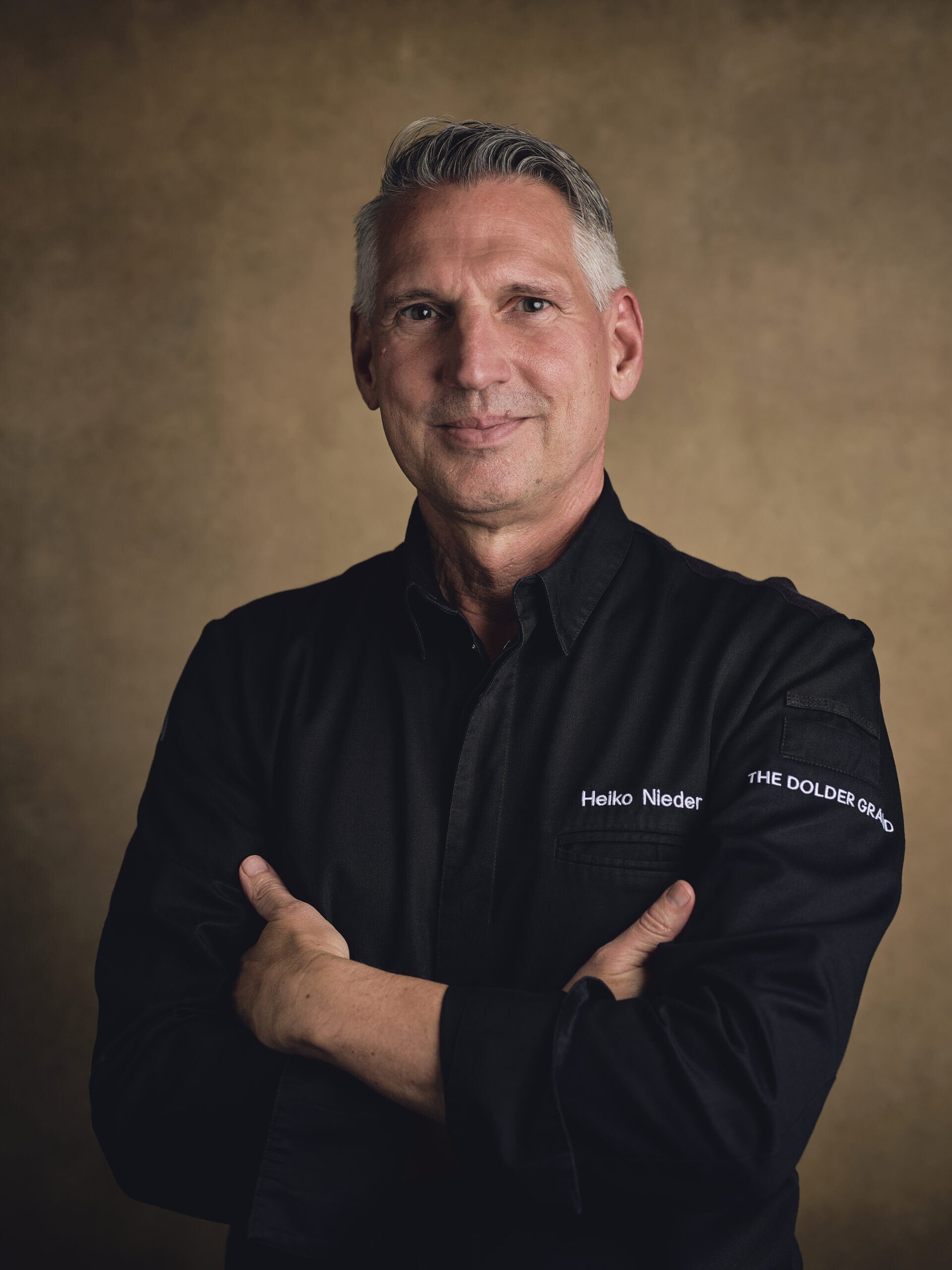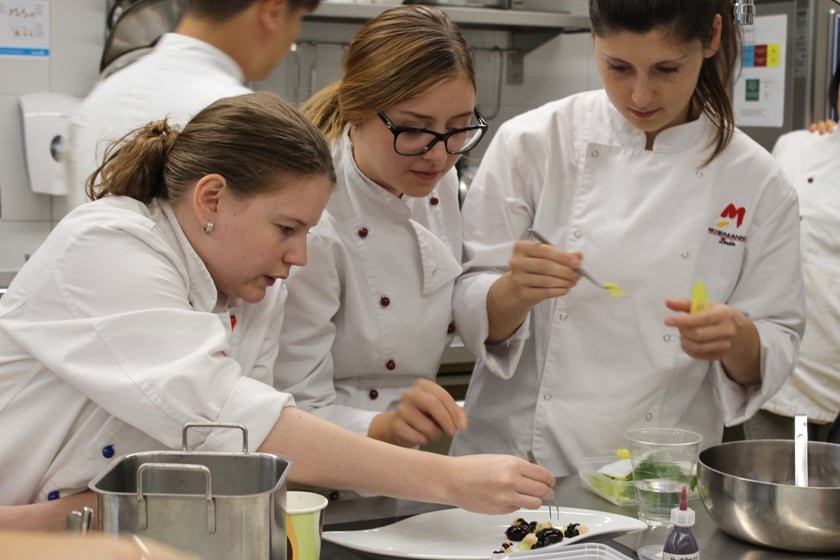Ever wanted to know the secrets behind the art of plating food like a top chef? The way a dish is presented on the plate plays a crucial role in the overall guest dining experience. All of our senses are engaged when we're dining out; sound, smell, and touch are all important elements in restaurants, but sight has particular value beyond the present moment. The use of imagery to draw in customers and tempt patrons to try a dish, paired with the far-reaching nature of social media means that food presentation is more important than ever.
Research conducted by Oxford psychologist, Professor Charles Spence, indicates that the presentation of food can significantly enhance the taste of a dish. Skilled chefs meticulously design the layout of ingredients to create a symphony of flavors and textures, enticing diners with their innovative plating techniques even before the first bite is taken.
The EHL Professional Path students of the Major in Culinary Arts participate in a workshop that provides them with insights into this essential component of gastronomy from one of the best restaurants in Switzerland.
André Wehrstedt, since 2008 Sous Chef at Heiko Nieder's The Restaurant at the Dolder Grand Hotel, revealed the secrets behind their signature dishes rated 19-point by the Gault Millau. A report by Alina Fritzenwallner.
Why is plating so important to food businesses?
Food presentation and marketing
For those in the food service industry, it's no secret that the art of food presentation plays a vital role in showcasing your restaurant's offerings, especially in the age of social media marketing on platforms like Instagram.
Whether you own a fine dining establishment, gastropub, or eclectic cafe, thoughtful plating will attract customers and earn their loyalty. Even before they sample your meal, your guests will eat with their eyes.
To test this theory, Oxford researchers plated the same meal two ways, artfully and without attention, and diners reported that the artfully plated version tasted better. By integrating basic food presentation techniques, styles, and tools, you can enhance your plating process and increase your menu prices without deterring customers.
When plating your dishes, each element matters equally: colour, arrangement, balance, texture, and how easy it is for guests to eat. If you hit each of these out of the park, you’re setting yourself up to get rave reviews and user-generated content that you can share on your social channels for some extra publicity.
The 10 principles of food plating
There are 10 main principles to follow for arranging your plate in a way that reflects your establishment's aesthetics and appeals to the diner, holds the structural integrity of the food, and sets them up for the perfect mix of flavours and textures in each bite.
- The rule of thirds - Often found in nature and in art to refer to a visually appealing layout which when applied to cooking, means placing the main component of your dish on the left or right side of the plate, instead of the center.
- The clock technique - Imagine arranging your ingredients like the hands of a clock. For the perfect visual balance, position your protein between 3 and 9, your starch/carbohydrate from 9 to 12, and your vegetable from 12 to 3, all from the diner's perspective.
- Select the right plate - Your plates don't have to be white and round, think about matching your tableware to the theme of the restaurant and also an appropriate shape for the dish. Think rectangular plates for a line of freshly rolled sushi, but a plate with a small well in the bottom for a dish with more liquid.
- Give height to the plate - Top chefs will usually play with height on a dish, showing off their delicate plating skills like stacking Jenga. This style allows you to get more on the plate in a visually appealing way so that all the elements are connected. Try perching a neat quenelle of thick cream or ice cream on top of your dessert!
- Begin with moist ingredients - Start by plating the moist ingredients to ensure they stay in place, then layer them with complementary foods to prevent any unwanted spillage. For instance, consider artistically arranging sliced meat against a bed of creamy mashed vegetables.
- Slide meat horizontally - Cut your meat on a 45-degree bias and against the grain of the meat. This is both practical as it makes for a more tender cut and it also shows off the "cuisson" of the meat. This angle also works well for fish and vegetables too!
- Create flavor combinations - Arrange the plate in such a way that blends all the elements of your dish in each mouthful. These flavor-packed bites are crucial for exceptional plating, delighting both the senses and the palate.
- Use bold color - Food, especially veggies, come in all kinds of vibrant shades, selecting ingredients that both taste amazing together and gorgeous color transforms your dish into a work of art. Think bright beetroot against black squid ink pasta, or rich berry compote contrasted with a creamy white pannacotta.
- Vary textures - Pairing a velvety vegetable puree with a crispy parmesan tuile creates a delightful interplay of textures that is a hallmark of upscale culinary artistry.
- Less is more - Ever noticed that the best restaurants give modest portions? Simplify your presentation by spotlighting a single ingredient, typically the protein. Creating a focal point allows for a harmonious arrangement of complementary elements that enhance your star component.

Learn the 10 food plating techniques, according to top chefs!




Small portions but quality ingredients and big flavors are the markers of a high-calibre restaurant.
Essential plating tools
Professional tools are a must-have for perfecting commercial plating. We have curated a selection of essential items that will elevate your food presentations to restaurant-quality standards.
- Decorating brushes: Assisting in intricate line work and creating bold strokes of sauce, decorating brushes are versatile tools that can also be utilized to craft a base of puree or coulis for meats and vegetables.
- Molds: Enhance visual allure by meticulously shaping ingredients into specific sizes and shapes. Utilize ring molds to add height and structural elegance when layering ingredients.
- Precision tongs: Assist in delicately placing garnishes or small items with precision tongs, which often come equipped with micro-serrations for enhanced grip and stability.
- Plating wedges: With their flat, round, or pointed edges, these tools are ideal for effortlessly spreading soft ingredients and crafting intricate sauce designs.
- Shavers: This implement enables you to elegantly garnish your dishes with finely shaved or grated chocolate, aged cheese, or delicate vegetables.
- Plating spoons: These come in in varying sizes are essential to the art of food presentation. Saucier spoons are perfect for elegantly swirling sauce on your plate, while slotted spoons effortlessly separate solids from liquids.
- Squeeze bottles: Allowing for precise application of sauce and aioli onto your plated masterpiece, these squeeze bottles often come equipped with adjustable precision control tips.

The EHL workshop on food plating
An amuse bouche as a start
The Modern Plating course started with the artful arrangement of an aperitif consisting of seven vegetarian components. André Wehrstedt, Sous Chef at the Dolder since 2008, completed every single work of art with great precision and speed. Afterwards, the students had the opportunity to recreate the extraordinary creations.
A balanced proportion of menu components is crucial
Fortunately, the individual menu components were brought along by the Sous Chef, and "only" had to be assembled. "Only"? This turned out to be a bigger challenge than first expected because of the proportion. For example, pumpkin puree and grated cheese, must always be balanced. This means that too much puree or too much cheese can not only falsify the appearance but also the final taste and ruin the whole idea behind the dish.
When arranging the plates press on the tempo
The tempo also plays a major role in arranging. Working too slowly can lead to factors such as crunchiness or creaminess being lost - even before the delicacies can be presented to the guest.
Course by course to artful arrangement
After the starter, the next challenges followed step by step. André Wehrstedt showed the culinary arts students some of the creations of "The Restaurant" of the Dolder Grand Hotel. The tweezers were also used extensively in the modern plating of the Dolder dishes, but this is entirely in keeping with the precision and refinement of the dishes. Without their use, such fine dishes could not be created.
The students then had the opportunity to compose their own creations using the components the Sous Chef had brought with him. The difference to Heiko Nieder's masterpiece is clearly visible. The refinement behind the arrangement of the sous chef cannot be learned from theory. Rather, the eye must be trained. How does that work? By constantly trying out and testing different variations.
There are no rules in modern plating
Always keeping up and trying is also the message that André Wehrstedt gave us students: In Modern Plating there are no rules, no wrong, and no right. It is important not to lose the courage to innovate and to let creativity prevail.

About Heiko Nieder
Heiko Nieder is the Executive Chef of Fine Dining at The Dolder Grand rated 19 points at the Gault Millau and awarded 2 Michelin Guide stars.
Heiko Nieder has been the head of Fine Dining since the opening of The Dolder Grand. He has repeatedly received awards for his creations, which are characterized by an impressive spectrum of flavors.






